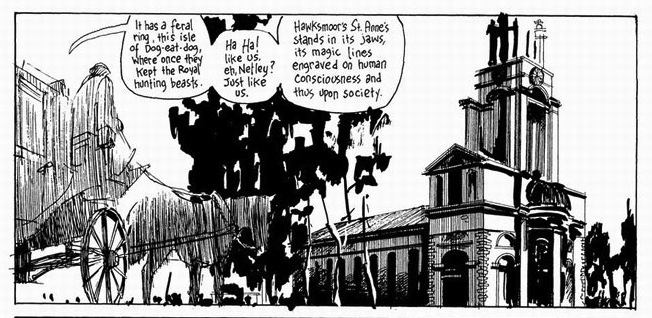Psycho geography #9 Hawksmoor

Oliver Ho: This article comes from a friend of mine, who introduced me to the subject. Its the idea that places are have a resonance about that, that they express ideas through their geography. The idea that places and buildings are loaded with meaning opens up the world to us, and we start to see our every day life in diferrent ways. We traveled around london to explore the churches of an architect called Hawksmoor, there are some interesting patterns to how these churches are placed in london, patterns that relate to egyptian mythology. Its still something of an obscure set of ideas but there are authors who have brought it to more mainstream attention like Ian Sinclair and Alan Moore.
Psycho-geography was something I did before I knew there was a word for it. It is the wonder of wandering in an unfamiliar city-scape. You never know what sight, sound or sensation you'll get. It's a pedestrian meditation; unguided your feet lead your experience from one episode to the next. Not knowing where you're going, not having a plan, is essential; freed from the need to have a destination you move in a non-directed, chaotic way, freeing the imagination from routines. It's not everyone's idea of fun, but, for me, when I was living in Whitechapel, the City of London called to me like an unexplored labyrinth.
The place is nearly deserted at weekends, full of contrasts between the ancient and modern, tiny alleys and massive status symbols. I would explore for a few hours, getting progressively more confused and dis-orientated, sometimes finding myself next to a world-famous landmark a minute later. The process of drifting astray and finding myself again was fun, and, better than that, cathartic. The tension of getting lost, the relief of seeing something familiar again, helped process whatever else I had going on. Psychogeography can be deeply meditative. It can also be deeply stupid, I went a few times with friends; alcohol needs to be kept subtle as the City Police don't have much to do (they deal in street crime, not fraud, embezzlement, insider trading etc), but we spent a few fun nights there at the weekend, sometimes a group of us would go, sometimes just two of us.
Anyway this habit really kicked in for me when someone told me what I was doing was 'Psychogeography'. That sounded cool.
If you're into theory, tradition and depth of understanding I'd recommend you check our Peter Ackroyd on all this. He is some kind of modern-day geomancer, he draws inspiration from the place he's in, to paraphrase him: some places have qualities that aren't subject to rational analysis. Why, for example, was Tyburn a place of death? Was there something about the place before the executions started that made it attractive to that form of activity? Does Tyburn echo still with some unseen resonance of all that hanging, drawing and quartering? Reductively this is easy to dismiss as Romantic, New-Age and a-scientific: but it is also a fact that very few birds sing, and very few insects crawl at Auschwitz.
We respond to the energy of our environments, there is a tradition of harnessing this that goes back millennia, and this tradition has devotees today.
In the literature of Psycho-geography one name stands out: Iain Sinclair. He writes deliberately dense and unwieldy poems in a stream-of-conscious, art-for-art's-sake kind of way. I was told that Sinclair's 'Lud Heat' had inspired Peter Ackroyd to write one of his best selling novels 'Hawksmoor'. I would highly recommend both.
What both allude to is one of the great works of psycho-geography, something of an open secret in London.
Nicholas Hawksmoor was assistant to Christopher Wren in rebuilding the City after the great fire of 1666 and as, a result of the 50 Churches Act of 1711, was commissioned to design churches that were to be built in the East-End of London. All sorts of weird and wonderful Christian sects existed in the East-End, they saw the Universe differently to members of the Established Church. For example, William Blake's sect the Moravians were alleged to practice sex-magic based on the kabbalah, they used 22 positions, one for each letter of the hebrew alphabet. Their exact beliefs and practices are still a mystery, but make the point, to view God differently from the Establishment was to see the Universe differently, Charles II blamed the 'London mob', and their weird beliefs, for the execution of his father.
The 50 churches act didn't achieve its stated objective, 12 churches were built, most of which weren't even in the east end. This was intentional, you can't build a church in the wrong place by accident. Whatever the excuse was, Hawksmoor got to create a masterpiece of Psycho-geography.
This is the layout of the Hawksmoor designed churches in London. In 'Lud Heat' Iain Sinclair walks from Limehouse in the East to Holborn in the West and notes the changing atmosphere. In Ackroyd's 'Hawksmoor' the churches form part of a diabolical spell. There is clearly something going on.
There is clear symmetry in the creation of the central square, and the distances between the churches are all roughly 3000 cubits, a distance with specific Biblical meaning. If you see nothing but pareidolia in this then can I recommend you get out a map of London. Find Greenwich Naval Hospital (designed by Hawksmoor though usually credited to Wren) and draw a line down the road that runs down the central axis of the building. Extend that line northward and it will meet St Anne's Limehouse, no. 3, on the map. Hawksmoor was definitely building a series of interconnected buildings, his intention was to harness the Psycho-geographic power of each place.
The different Orders of Column used in the churches illustrates the point. In Classical Architecture the different Orders of Column related to the different type of people associated with the building. Plain Doric columns, used in the East-End Churches, were there to reflect the plain, poor folk of the parish, to capture their essence in stone. Conversely the highly decorative Corinthian columns used in the West-End Churches suited the moneyed types who lived, worked and prayed thereabouts. Hawksmoor's Churches reflect each parish's mood back on them, like town planning written in code.
The trouble Hawksmoor went to to acquire the specific plots of land all the Churches are built on is a matter of record. The only time he didn't get the plot he wanted, for St George's in Wapping, is the only church that doesn't perfectly fit his 3000 cubit scheme.
But why bother? What lay behind his scheme? This had everything to do with what he believed, his God.
In the Story of Isis and Osiris their son, Horus, fights and kills his evil uncle, Set. In the battle, however, Horus loses an eye. Thoth, the God of wisdom helps put the eye back together, first he finds a half of it, then a quarter, an eighth and so on, ad infinitum. Poor Thoth is still trying to put the Eye of Horus back together!
Hieroglyphics apparently have multiple uses and meanings, in order to make sense of them you've often got to make use of the context they appears in: just like his churches!
Article by the excellent Rob Shaw





















Must Reads
David Holmes – Humanity As An Act Of Resistance in three chapters
As a nation, the Irish have always had a profound relationship with the people of Palestine
Rotterdam – A City which Bounces Back
The Dutch city is in a state of constant revival
Going Remote.
Home swapping as a lifestyle choice
Trending track
Vels d’Èter
Glass Isle
Shop NowDreaming
Timothy Clerkin
Shop Now